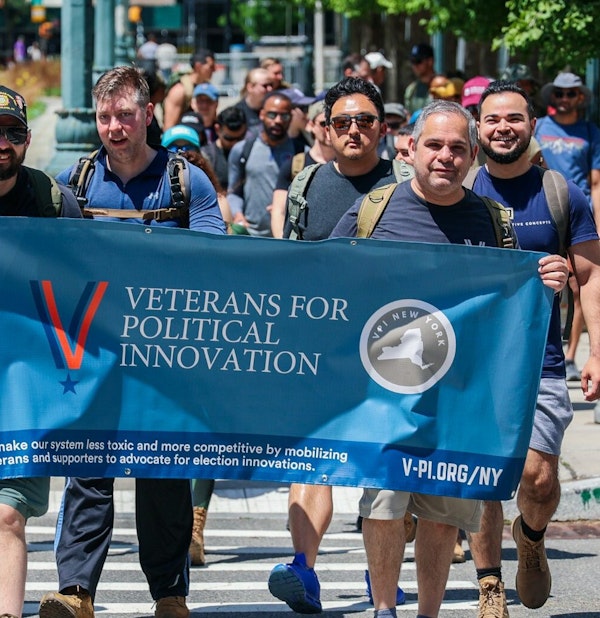Protecting those who protect us
Disinformation campaigns often target U.S. military veterans, increasing the threat of violent extremism. Here’s how to keep them – and the rest of us – safe.
 A veteran at a job fair in Quantico, Virginia on August 8, 2008. (Photo by Alex Wong/Getty Images
A veteran at a job fair in Quantico, Virginia on August 8, 2008. (Photo by Alex Wong/Getty Images
Disinformation is one of the greatest threats now facing U.S. democracy. The ability of U.S. citizens to accurately perceive reality – along with their commitment to the rules-based order established by the Constitution – is being steadily undermined by this increasingly dangerous phenomenon. Not only is the spread of false information inherently harmful, but disinformation is also breeding a type of radicalization that all too often devolves into violent extremism. What’s worse, many disinformation campaigns deliberately target a small but particularly vulnerable group: U.S. military veterans. Disinformation and the extremism it sows are problems that the United States must meet head-on for all its citizens, but right now, veterans face some of the greatest risks. If we can figure out better ways to help them, it will pave the way for solutions that can help all Americans.
For two decades after the terrorist attacks on Sept. 11, 2001, the United States relied on its men and women in uniform to defend the country against foreign radicals. That makes it a bitter irony that when the United States faced a violent threat on Jan. 6, 2021, as many as 14.6% of those prosecuted for attacking the U.S. Capitol had a history of service in the U.S. Armed Forces. As that figure highlights, we cannot continue to allow our veterans to be victimized by information warfare, especially at a moment when the country is suffering so much anger and bitterness. We owe it to our servicemembers – and ourselves – to provide them with resources to protect themselves from malicious fake news and to provide them with the ability to safely address any feelings of frustration or despair they might have toward society or government.
The Department of Veterans Affairs (VA) and the country’s various veteran services organizations (VSOs) are already equipped with many of the resources needed to address this danger. The problem is that these entities don’t offer programs explicitly aimed at helping veterans reduce their vulnerability to disinformation and the extremism it may inspire. The Department of Homeland Security, meanwhile, provides such programs for the general public but offers nothing specifically tailored to veterans. As the consumption and acceptance of disinformation grows more common in the United States, the government and nongovernmental organizations must find ways to give veterans the support they need to mitigate the influence of these malevolent forces coming from within and from abroad.
Veterans’ vulnerabilities
A variety of malign actors – including Russian and Iranian information operations forces – have honed in on U.S. veterans with significant success. Such campaigns pose a number of dangers to American society, some less obvious than others. To begin with, veteran involvement in extremism risks undermining the public’s trust in the military. A recent poll found that popular support of the armed services is already at its lowest level since 1997. This erosion of trust could hurt the quantity and quality of recruitment to the all-volunteer force, thereby endangering U.S. national security.
The presence of veterans in extremist organizations also helps legitimize their actions and existence. Terror attacks perpetrated by people with a record of U.S. military service are notably deadly. A 2023 analysis from the University of Maryland’s National Consortium for the Study of Terrorism and Responses to Terrorism (START) showed that in mass-casualty attacks – those with four or more victims – the most common characteristic of the perpetrator is a U.S. military background. While a study from RAND notes that there is “no evidence to support the notion that the veteran community, as a whole, manifests higher rates of support for violent extremist groups or extremist beliefs than the American public,” a separate analysis from START shows that over the past 30 years, the number of veterans involved in extremist crimes has shot up 315%. When combined, what the two studies suggest is that, while the percentage of extremists may not differ much between the two groups, veterans who do subscribe to extremist beliefs are more likely to act on them with deadly results than the average citizen.
Veterans may be particularly susceptible to disinformation because of the emotional stresses that can emerge when leaving the service. Military service can be traumatic, and the transition to civilian life is difficult even in the best of times. It can cause loneliness and disrupt one’s sense of identity, making those who may be struggling to find a sense of community prime targets for disinformation campaigns.
 Veterans march for election reform in New York on June 10, 2023. (Photo via Twitter (X)/Veterans for All Voters)
Veterans march for election reform in New York on June 10, 2023. (Photo via Twitter (X)/Veterans for All Voters)
A helping hand
The VA and VSOs offer plenty of programs designed to help veterans make the transition into civilian life, but not enough are designed to help them identify and resist disinformation and the extremism it leads to. Existing programs that address the mental strain of military service, combat experience, and the return to civilian life generally fail to consider how those factors can also open the door to radicalization. That failure creates a gap the country must fill. The United States needs a holistic and preventative public health approach to countering extremism in the veteran community. Luckily, the VA and VSOs are already so well equipped and so familiar with the veteran population that adding programs to help vets resist disinformation and prevent extremism should not be difficult.
One good place to start would be with programs designed to combat and treat addiction. That’s because addiction and extremism affect the brain in similar ways. The behavioral patterns of those attempting to rehabilitate themselves from extremist ideologies are very similar to those of recovering drug abusers. Given this commonality, interventions that have been successful in countering substance abuse should be adapted to counter similar addictions to hate and conspiracy theories. Such programs already exist – organizations like Life After Hate operate much like Alcoholics Anonymous or other 12-step programs – but they’re not tailored to the specific problems and experiences of retired servicemembers. And while many VA medical centers offer substance abuse programs, none offer programs like Life After Hate.
Although the U.S. government is already working hard to combat the rise of domestic terrorism in the United States, so far its solutions have largely neglected the veteran community. The White House released a National Strategy for Countering Domestic Terrorism in June 2021, but the 32-page document hardly mentions veterans at all. The Department of Homeland Security has recently developed the Center for Prevention Programs and Partnerships (CP3) to address this problem among civilians, but it is also not tailored for veterans. The CP3 provides financial, educational, and technical assistance to community-based efforts focusing on addressing early risk factors, ensuring individuals receive help before they radicalize to violence. It wouldn’t take much for the VA and Department of Defense (DOD) to integrate a system like the CP3 into their own existing resources.
The way of the web
Even if the VA and DOD develop programs to help veterans combat disinformation and the extremism it may lead to, such work won’t solve the problem on its own. Disinformation spreads primarily through the digital commons, so we also need online tools to detect these ideologies as they make their way toward and through the veteran community on the web. Such tools would allow the VA and VSOs to proactively mobilize resources to help vulnerable individuals before they fall down the rabbit hole of radicalization. These days, before anyone does anything, they tend to search the internet for information on how to do it. Population-level data from Google keyword searches is already used to track the proliferation of contagious diseases and can be similarly used to monitor the spread of disinformation and extremism. Just like wastewater is now being routinely tested to provide early warnings for outbreaks of diseases, the United States should monitor the metadata of digital pathways to identify communities at risk and proactively mobilize the resources required to help them.
Organizations like Moonshot have concluded that a particularly successful way of reaching at-risk people is through online means. They have determined that members of extremist groups are up to 115% more likely to accept psychological support services when they’re offered online – particularly when those services are tailored to those feeling isolated. This technique could prove incredibly useful if scaled toward the veteran community. A 2017 RAND study highlighted the value of social media in reaching veterans who engage in self-harming behavior but are unlikely to seek care. The research showed that even a very short, web-based intervention could greatly reduce such risky activities. Creating a DOD or VA program using this technique would not be a major undertaking or a major strain on the taxpayer dollar, and such a program should be implemented as soon as possible.
If we can help solve this problem for veterans, the solutions discovered in the process can be used more broadly throughout the United States. Many veterans are already standing up against divisiveness and working together to strengthen U.S. democracy. Organizations like We the Veterans and Veterans for All Voters are helping bridge political divides, enhancing public awareness of civic duties, and protecting election integrity.
The military and veteran community could be a transformative force for positive change not only in the area of disinformation and extremism but also in the larger battle against polarization and partisanship. Over 80% of Americans believe that political hostility and divisiveness are a serious problem. Most Americans support bipartisan collaboration, and most agree that polarization can be overcome with civic, educational, and political reforms that encourage constructive disagreement. The veteran community has the potential to be a defining force in the rehabilitation of a more unified political ideology in the United States. A 2019 Harvard study on more than 100 years of coordinated campaigns by various peoples looking to make changes in government or policy found that it only takes about 3.5% of the population to join a nonviolent movement in order to produce significant results. Right now, veterans make up 6% of the U.S. population. The veteran community is therefore large enough to lead the way in implementing solutions for the rest of the country. All that is needed is a cohesive program to rally them to this cause.
The military community needs to adopt a more holistic approach, as well as more innovative solutions, if it is going to help its veterans resist disinformation and mend the nation’s divisions. But the tools already exist; they just need to be properly used. U.S. military veterans have a proud history of standing up for democracy. The vast majority continue to do so. It’s now time to help those struggling with their darker angels to rejoin the fight to protect our country from threats both without and within. They need the resources to do so – and it’s our duty to make sure they get them.
The Catalyst believes that ideas matter. We aim to stimulate debate on the most important issues of the day, featuring a range of arguments that are constructive, high-minded, and share our core values of freedom, opportunity, accountability, and compassion. To that end, we seek out ideas that may challenge us, and the authors’ views presented here are their own; The Catalyst does not endorse any particular policy, politician, or party.

